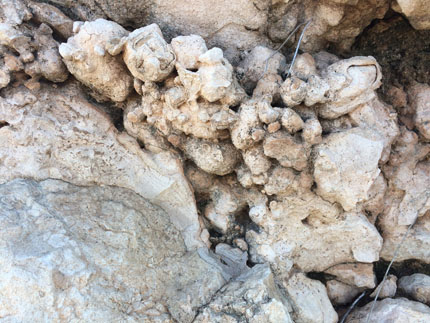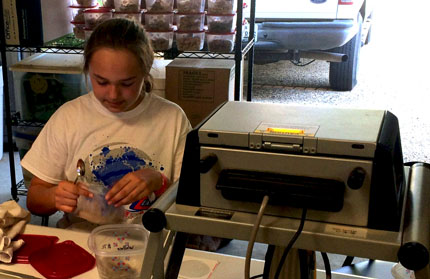5585 Guilford Road • Madison, WI 53711-5801 • 608-273-8080 • Fax 608-273-2021
www.agronomy.org
Twitter | Facebook
NEWS RELEASE
Contact: Hanna Jeske, Associate Director of Marketing and Brand Strategy, 608-268-3972, hjeske@sciencesocieties.org
Alkaline soil, sensible sensor
Aug. 2, 2017 - Producers sometimes face challenges that go deep into the soil. They need answers to help the soil, on site. A portable field sensor can accurately measure minerals in soils more easily and efficiently than existing methods. And a research team, including a middle school student and her scientist father, can confirm it.
 Calcium, like other minerals, is necessary for healthy plant growth. However, an excess of calcium — particularly in the form of calcium carbonate — can cause issues as it builds up in the soil.
Calcium, like other minerals, is necessary for healthy plant growth. However, an excess of calcium — particularly in the form of calcium carbonate — can cause issues as it builds up in the soil.
“Calcium carbonate is basically a type of salt. It dissolves in water after a rainfall event and moves down through the soil,” explains David Weindorf. Weindorf is at the Department of Plant and Soil Science at Texas Tech University.
One main source of this calcium is limestone. At low levels, it makes thin threads or small white masses in the soil. However, in extreme cases it can actually take over the entire subsoil. Its hard surface can limit the ability of plant roots to grow. Getting this information on-the-fly is important for growers and soil scientists solving problems in the field.
Traditionally, soil scientists use their expertise to look at the soil and determine the stage of the calcium visually. There are also laboratory-based techniques that are very accurate, but they are not portable. The researchers wanted to see if a portable x-ray device — called PXRF, portable x-ray fluorescence spectrometry — would be better.
Based on their comparisons, the researchers found that, indeed, the device is a good method for measuring the calcium in the soil. The device can provide data on about 20 different elements, all in 60 seconds.
This can be a big advantage for soil scientists working in the field. It can also help scientists and farmers in developing countries who can’t afford expensive laboratory tests, or don’t have the expertise to visually appraise the soil.
 “We are not advocating doing away with traditional assessment. We are simply providing a new data stream to help field soil scientists when evaluating carbonates in the field,” Weindorf explains. “Essentially, PXRF is another tool in the tool belt of the modern soil scientist, but it is by no means the only tool.”
“We are not advocating doing away with traditional assessment. We are simply providing a new data stream to help field soil scientists when evaluating carbonates in the field,” Weindorf explains. “Essentially, PXRF is another tool in the tool belt of the modern soil scientist, but it is by no means the only tool.”
Weindorf’s daughter was also part of the research. For Camille, this study was a way to branch out for her school’s science fair and do some original research. She scanned the soil samples and then helped her father perform the laboratory tests. She also helped calculate the summary statistics and write the paper.
“As a father, I just can’t overemphasize how proud I am of my daughter for taking on this science challenge with me,” he says. “I hope a project like this can inspire other students around her age to engage in original scientific inquiry. Truly, they are the future which will keep our country at the forefront of scientific innovation.”
Read this study in the Soil Science Society of American Journal. Support for this research came from the BL Allen Endowment in Pedology at Texas Tech University.
Soil Science Society of America Journal is the flagship journal of the SSSA. It publishes basic and applied soil research in soil chemistry, soil physics, soil pedology, and hydrology in agricultural, forest, wetlands, and urban settings. SSSAJ supports a comprehensive venue for interdisciplinary soil scientists, biogeochemists, and agronomists.